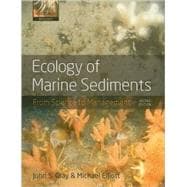
Note: Supplemental materials are not guaranteed with Rental or Used book purchases.
Purchase Benefits
Looking to rent a book? Rent Ecology of Marine Sediments [ISBN: 9780198569022] for the semester, quarter, and short term or search our site for other textbooks by Gray, John S.; Elliot, Michael. Renting a textbook can save you up to 90% from the cost of buying.
| A tribute to John Stuart Gray (1941-2007) | p. ix |
| Introduction | p. 1 |
| Sampling sediments | p. 11 |
| Sampling design | p. 11 |
| Sampling the fauna | p. 17 |
| The sediment and related environmental factors | p. 22 |
| Grain size and related variables | p. 22 |
| Other important environmental variables | p. 25 |
| The fauna and environmental variables | p. 30 |
| Describing assemblages of sediment-living organisms | p. 34 |
| Abundance models | p. 34 |
| Species occurrences | p. 38 |
| Size and biomass spectra | p. 40 |
| Describing faunal patterns | p. 41 |
| Describing assemblages | p. 44 |
| Diversity | p. 52 |
| Measuring diversity | p. 52 |
| Scale and biodiversity | p. 56 |
| Turnover (beta) diversity | p. 57 |
| Patterns of diversity in benthic assemblages | p. 59 |
| Latitudinal and longitudinal gradients of diversity | p. 65 |
| The link between species richness and system function | p. 67 |
| Functional diversity of benthic assemblages | p. 70 |
| Ecological functioning | p. 70 |
| Secondary production in benthic macrofauna | p. 71 |
| Production estimates in meiofauna | p. 76 |
| Energy budgets for single species | p. 77 |
| Elemental budgets | p. 79 |
| Production: biomass ratios | p. 79 |
| Community metabolism | p. 82 |
| Spatial variations in sediment systems | p. 89 |
| The importance of scale | p. 89 |
| Measuring scale effects on sediment systems | p. 93 |
| Biological interactions causing disturbances | p. 97 |
| The settlement process | p. 103 |
| Causes of change in dominance patterns | p. 105 |
| Generalizing effects of disturbance | p. 106 |
| Temporal variations in benthic assemblages | p. 109 |
| Seasonal patterns | p. 110 |
| Long-term patterns | p. 112 |
| The stability of benthic communities | p. 116 |
| Human impacts on soft-sediment systems-trawling and fisheries | p. 122 |
| Ecological effects of trawling | p. 122 |
| Common types of trawls and dredges | p. 126 |
| Effects of gear on different sediment types | p. 126 |
| General effects of trawling on benthic systems | p. 130 |
| Human impacts on soft-sediment systems-pollution | p. 133 |
| Effects of increased organic matter on numbers and biomass | p. 133 |
| Effects of organic enrichment on diversity | p. 134 |
| Effects of discharges from the oil industry | p. 136 |
| Effects of heavy metals and xenobiotic chemicals on benthic fauna | p. 141 |
| Adaptive strategies to pollution/disturbance | p. 144 |
| Sediment quality standards | p. 149 |
| Integrative benthic assessments | p. 152 |
| Recovery of the benthic community after stress | p. 154 |
| The soft-sediment benthos in the ecosystem | p. 157 |
| Food webs, and feeding and functional groups | p. 157 |
| Ecosystem models | p. 160 |
| Network analysis: cycling index and average path length | p. 160 |
| The European Regional Seas Ecosystem Model (ERSEM) | p. 164 |
| The benthos in the management of marine sediments | p. 171 |
| The use and analysis of benthic data | p. 171 |
| The DPSIR approach-indicators and objectives | p. 174 |
| Benthic monitoring | p. 180 |
| The role of the benthos in a priori assessments | p. 182 |
| The role of benthos in quality assessments | p. 186 |
| Predictive models and marine benthic management | p. 188 |
| Benthic analytical quality control and quality assurance (AQC/QA) and data reliability | p. 189 |
| Concluding remarks | p. 190 |
| References and Further Reading | p. 194 |
| Index | p. 215 |
| Table of Contents provided by Ingram. All Rights Reserved. |
The New copy of this book will include any supplemental materials advertised. Please check the title of the book to determine if it should include any access cards, study guides, lab manuals, CDs, etc.
The Used, Rental and eBook copies of this book are not guaranteed to include any supplemental materials. Typically, only the book itself is included. This is true even if the title states it includes any access cards, study guides, lab manuals, CDs, etc.